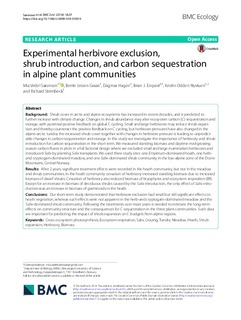| dc.contributor.author | Sørensen, Mia Vedel | |
| dc.contributor.author | Graae, Bente Jessen | |
| dc.contributor.author | Hagen, Dagmar | |
| dc.contributor.author | Enquist, Brian J. | |
| dc.contributor.author | Nystuen, Kristin Odden | |
| dc.contributor.author | Strimbeck, Richard | |
| dc.date.accessioned | 2018-10-11T08:24:00Z | |
| dc.date.available | 2018-10-11T08:24:00Z | |
| dc.date.created | 2018-08-31T10:59:33Z | |
| dc.date.issued | 2018 | |
| dc.identifier.issn | 1472-6785 | |
| dc.identifier.uri | http://hdl.handle.net/11250/2567557 | |
| dc.description.abstract | Background
Shrub cover in arctic and alpine ecosystems has increased in recent decades, and is predicted to further increase with climate change. Changes in shrub abundance may alter ecosystem carbon (C) sequestration and storage, with potential positive feedback on global C cycling. Small and large herbivores may reduce shrub expansion and thereby counteract the positive feedback on C cycling, but herbivore pressures have also changed in the alpine-arctic tundra; the increased shrub cover together with changes in herbivore pressure is leading to unpredictable changes in carbon sequestration and storage. In this study we investigate the importance of herbivory and shrub introduction for carbon sequestration in the short term. We measured standing biomass and daytime mid-growing season carbon fluxes in plots in a full factorial design where we excluded small and large mammalian herbivores and introduced Salix by planting Salix transplants. We used three study sites: one Empetrum-dominated heath, one herb- and cryptogam-dominated meadow, and one Salix-dominated shrub community in the low-alpine zone of the Dovre Mountains, Central Norway.
Results
After 2 years, significant treatment effects were recorded in the heath community, but not in the meadow and shrub communities. In the heath community cessation of herbivory increased standing biomass due to increased biomass of dwarf shrubs. Cessation of herbivory also reduced biomass of bryophytes and ecosystem respiration (ER). Except for an increase in biomass of deciduous shrubs caused by the Salix introduction, the only effect of Salix introduction was an increase in biomass of graminoids in the heath.
Conclusions
Our short-term study demonstrated that herbivore exclusion had small but still significant effects on heath vegetation, whereas such effects were not apparent in the herb-and cryptogam-dominated meadow and the Salix-dominated shrub community. Following the treatments over more years is needed to estimate the long-term effects on community structure and the consequences for C sequestration in the three plant communities. Such data are important for predicting the impact of shrub expansion on C budgets from alpine regions. | nb_NO |
| dc.language.iso | eng | nb_NO |
| dc.publisher | BMC (part of Springer Nature) | nb_NO |
| dc.rights | Navngivelse 4.0 Internasjonal | * |
| dc.rights.uri | http://creativecommons.org/licenses/by/4.0/deed.no | * |
| dc.title | Experimental herbivore exclusion, shrub introduction, and carbon sequestration in alpine plant communities | nb_NO |
| dc.title.alternative | Experimental herbivore exclusion, shrub introduction, and carbon sequestration in alpine plant communities | nb_NO |
| dc.type | Journal article | nb_NO |
| dc.type | Peer reviewed | nb_NO |
| dc.description.version | publishedVersion | nb_NO |
| dc.source.volume | 18 | nb_NO |
| dc.source.journal | BMC Ecology | nb_NO |
| dc.source.issue | 1 | nb_NO |
| dc.identifier.doi | 10.1186/s12898-018-0185-9 | |
| dc.identifier.cristin | 1605752 | |
| dc.description.localcode | © The Author(s) 2018. This article is distributed under the terms of the Creative Commons Attribution 4.0 International License (http://creativecommons.org/licenses/by/4.0/) | nb_NO |
| cristin.unitcode | 194,66,10,0 | |
| cristin.unitname | Institutt for biologi | |
| cristin.ispublished | true | |
| cristin.fulltext | original | |
| cristin.qualitycode | 1 | |

